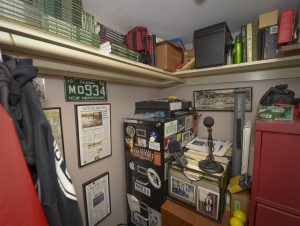Learning a New Way to Tell Stories
I began producing stories for Red River Radio a month or so ago. I was asked to help them expand their news coverage with piece every week or so. Sure, I said. It pays a modest amount, being public radio and all, but I’m happy to help. For nearly six years, I have contributed weekly commentaries gratis. Producing a news story is different. I ensconce my self in the small closet in my study, which is banked with file cabinets and boxes of unsold books, which doubles as a recording studio.
to help. For nearly six years, I have contributed weekly commentaries gratis. Producing a news story is different. I ensconce my self in the small closet in my study, which is banked with file cabinets and boxes of unsold books, which doubles as a recording studio.
(By the way, Christmas is coming, and a copy of “Yours Faithfully, J.A.: The Life and Writings of H.B. Fox, the Circleville Philosopher,” is a nice addition to one’s library. Paste the following link in your browser to order a signed copy: https://tinyurl.com/ybnpm9ho. End of shameless self-promotion and back to our primary topic.)
For my commentaries (redriverradio.org), my highly capable producer edits out my stumbling mispronounced words and tongue-tied mangling of the English language. For the news stories, I am on my own. I am slowly learning to use an audio software program to edit raw interviews and my voiceover into a usable piece.
The learning curve is steep. I use Adobe Audition, because it is included with my monthly subscription to the Adobe suite, which I use for graphic design and photography. But Audition is a foreign animal to someone who has spent his entire career working in print. I began watching YouTube tutorials, invariably moderated by young men who talked far too quickly. I would rewind and watch the same 15-second sequence repeatedly and still be clueless. So I reverted to form and ordered a how-to book for $50, which ate into my potential income from producing radio stories. Oh, well. Nobody expects to get rich toiling for NPR.
I went out and interviewed a few folks for a potential story and then came back and downloaded the clips onto Audition, following the instructions in the book — what few sentences I could decipher. I would have more success reading a book in Spanish than I was having understanding the textbook, but I did manage to get all the sound clips loaded. Painstakingly, I edited sound bites and spliced them together. The sound was not great. Seems like an air-conditioner kicked on in the midst of one interview, and background noise muffled another subject’s voice. Well, maybe it could be fixed just like my producer repairs my ramblings. I turned in the piece.
His reaction reminded me of when I submitted my first essay for a creative writing class at Stephen F. Austin State University. The English professor returned it with a grade of 60 and a terse note that I could do better than this. The producer sent a note that the sound was terrible and the piece unusable. He also sent a page of useful tips on how to build a radio interview. The key tip, which I had somehow overlooked the first time: Wear earbuds or headphones while recording so you can hear how the piece is actually going to sound.
It is a noisy world out there. My next attempt was at a weekly local event, where a musician was playing guitar and singing in the background. That will make a nice backdrop to my interview, I thought. When I later listened to the recording, I discovered the singer drowned out my interview. I’m sure someone who knows more about this mysterious software I use could have fixed that, but not me. I went back out to record the interview the following weekend, wary of the musician, passing trains and other noise.
Ever so slowly, I am learning how to do this. A couple of pieces have aired, with a few more scheduled. Learning how to communicate in a different medium is enjoyable if frustrating at times. I figure delving into such activities, where my comfort level and skill are both pretty low, is a useful brain exercise.
Besides, it’s fun to sign off: For Red River Radio News, this is Gary Borders in Longview, Texas.
Leave a reply
Fields marked with * are required











